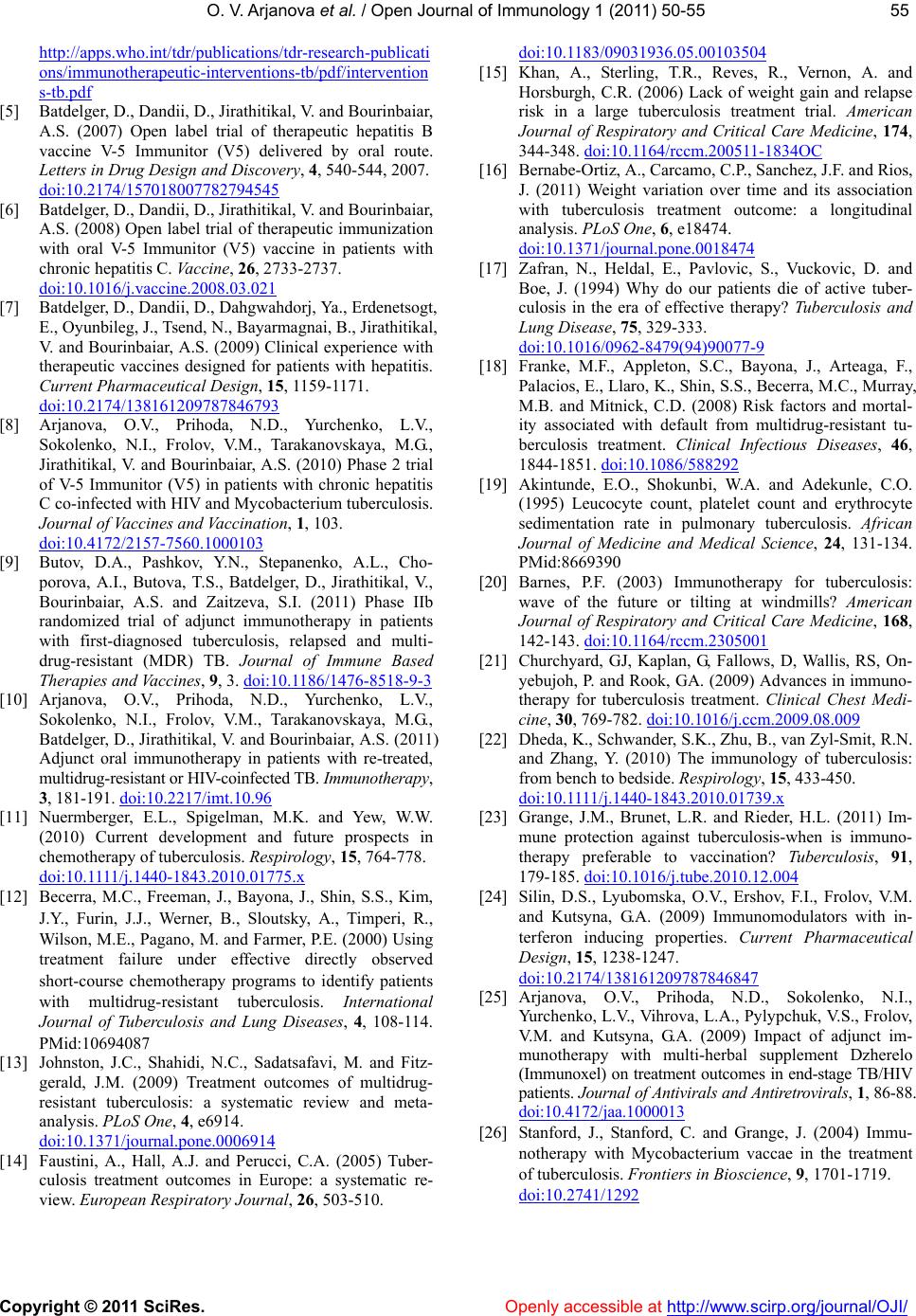
O. V. Arjanova et al. / Open Journal of Immunology 1 (2011) 50-55
Copyright © 2011 SciRes. http://www.scirp. org/journal/OJI/Openly accessible at
5555
http://apps.who.int/tdr/publications/tdr-research-publicati
ons/immunotherapeutic-interventions-tb/pdf/intervention
s-tb.pdf
[5] Batdelger, D., Dandii, D., Jirathitikal, V. and Bourinbaiar,
A.S. (2007) Open label trial of therapeutic hepatitis B
vaccine V-5 Immunitor (V5) delivered by oral route.
Letters in Drug Design and Discovery, 4, 540-544, 2007.
doi:10.2174/157018007782794545
[6] Batdelger, D., Dandii, D., Jirathitikal, V. and Bourinbaiar,
A.S. (2008) Open label trial of therapeutic immunization
with oral V-5 Immunitor (V5) vaccine in patients with
chronic hepatitis C. Vaccine, 26, 2733-2737.
doi:10.1016/j.vaccine.2008.03.021
[7] Batdelger, D., Dandii, D., Dahgwahdorj, Ya., Erdenetsogt,
E., Oyunbileg, J., Tsend, N., Bayarmagnai, B., Jirathitikal,
V. and Bourinbaiar, A.S. (2009) Clinical experience with
therapeutic vaccines designed for patients with hepatitis.
Current Pharmaceutical Design, 15, 1159-1171.
doi:10.2174/138161209787846793
[8] Arjanova, O.V., Prihoda, N.D., Yurchenko, L.V.,
Sokolenko, N.I., Frolov, V.M., Tarakanovskaya, M.G.,
Jirathitikal, V. and Bourinbaiar, A.S. (2010) Phase 2 trial
of V-5 Immunitor (V5) in patients with chronic hepatitis
C co-infected with HIV and Mycobacterium tuberculosis.
Journal of Vaccines and Vaccination, 1, 103.
doi:10.4172/2157-7560.1000103
[9] Butov, D.A., Pashkov, Y.N., Stepanenko, A.L., Cho-
porova, A.I., Butova, T.S., Batdelger, D., Jirathitikal, V.,
Bourinbaiar, A.S. and Zaitzeva, S.I. (2011) Phase IIb
randomized trial of adjunct immunotherapy in patients
with first-diagnosed tuberculosis, relapsed and multi-
drug-resistant (MDR) TB. Journal of Immune Based
Therapies and Vaccines, 9, 3. doi:10.1186/1476-8518-9-3
[10] Arjanova, O.V., Prihoda, N.D., Yurchenko, L.V.,
Sokolenko, N.I., Frolov, V.M., Tarakanovskaya, M.G.,
Batdelger, D., Jirathitikal, V. and Bourinbaiar, A.S. (2011)
Adjunct oral immunotherapy in patients with re-treated,
multidrug-resistant or HIV-coinfected TB. Immunotherapy,
3, 181-191. doi:10.2217/imt.10.96
[11] Nuermberger, E.L., Spigelman, M.K. and Yew, W.W.
(2010) Current development and future prospects in
chemotherapy of tubercul osi s. Respirology, 15, 764-778.
d oi:10. 1111/j.1 440-1843.2010.01775.x
[12] Becerra, M.C., Freeman, J., Bayona, J., Shin, S.S., Kim,
J.Y., Furin, J.J., Werner, B., Sloutsky, A., Timperi, R.,
Wilson, M.E., Pagano, M. and Farmer, P. E. (2000) Using
treatment failure under effective directly observed
short-course chemotherapy programs to identify patients
with multidrug-resistant tuberculosis. International
Journal of Tuberculosis and Lung Diseases, 4, 108-114.
PMid:10694087
[13] Johnston, J.C., Shahidi, N.C., Sadatsafavi, M. and Fitz-
gerald, J.M. (2009) Treatment outcomes of multidrug-
resistant tuberculosis: a systematic review and meta-
analysis. PLoS One, 4, e6914.
doi:10.1371/journal.pone.0006914
[14] Faustini, A., Hall, A.J. and Perucci, C.A. (2005) Tuber-
culosis treatment outcomes in Europe: a systematic re-
view. European Respiratory Journal, 26, 503-510.
doi:10.1183/09031936.05.00103504
[15] Khan, A., Sterling, T.R., Reves, R., Vernon, A. and
Horsburgh, C.R. (2006) Lack of weight gain and relapse
risk in a large tuberculosis treatment trial. American
Journal of Respiratory and Critical Care Medicine, 174,
344-348. doi:10.1164/rccm.200511-1834OC
[16] Bernabe-Ortiz, A., Carcamo, C.P., Sanchez, J.F. and Rios,
J. (2011) Weight variation over time and its association
with tuberculosis treatment outcome: a longitudinal
analysis. PLoS One, 6, e18474.
doi:10.1371/journal.pone.0018474
[17] Zafran, N., Heldal, E., Pavlovic, S., Vuckovic, D. and
Boe, J. (1994) Why do our patients die of active tuber-
culosis in the era of effective therapy? Tuberculosis and
Lung Disease, 75, 329-333.
doi:10.1016/0962-8479(94)90077-9
[18] Franke, M.F., Appleton, S.C., Bayona, J., Arteaga, F.,
Palacios, E., Llaro, K., Shin, S.S., Becerra, M.C., Murray,
M.B. and Mitnick, C.D. (2008) Risk factors and mortal-
ity associated with default from multidrug-resistant tu-
berculosis treatment. Clinical Infectious Diseases, 46,
1844-1851. doi:10.1086/588292
[19] Akintunde, E.O., Shokunbi, W.A. and Adekunle, C.O.
(1995) Leucocyte count, platelet count and erythrocyte
sedimentation rate in pulmonary tuberculosis. African
Journal of Medicine and Medical Science, 24, 131-134.
PMid:8669390
[20] Barnes, P.F. (2003) Immunotherapy for tuberculosis:
wave of the future or tilting at windmills? American
Journal of Respiratory and Critical Care Medicine, 168,
142-143. doi:10.1164/rccm.2305001
[21] Churchyard, GJ, Kaplan, G, Fallows, D, Wallis, RS, On-
yebujoh, P. and Rook, GA. (2009) Advances in immuno-
therapy for tuberculosis treatment. Clinical Chest Medi-
cine, 30, 769-782. doi:10.1016/j.ccm.2009.08.009
[22] Dheda, K., Schwander, S.K., Zhu, B., van Zyl-Smit, R.N.
and Zhang, Y. (2010) The immunology of tuberculosis:
from bench to bedside. Respirology, 15, 433-450.
d oi:10. 1111/j.1 440-1843.2010.01739.x
[23] Grange, J.M., Brunet, L.R. and Rieder, H.L. (2011) Im-
mune protection against tuberculosis-when is immuno-
therapy preferable to vaccination? Tuberculosis, 91,
179-185. doi:10.1016/j.tube.2010.12.004
[24] Silin, D.S., Lyubomska, O.V., Ershov, F.I., Frolov, V.M.
and Kutsyna, G.A. (2009) Immunomodulators with in-
terferon inducing properties. Current Pharmaceutical
Design, 15, 1238-1247.
doi:10.2174/138161209787846847
[25] Arjanova, O.V., Prihoda, N.D., Sokolenko, N.I.,
Yurchenko, L.V., Vihrova, L.A., Pylypchuk, V.S., Frolov,
V.M. and Kutsyna, G.A. (2009) Impact of adjunct im-
munotherapy with multi-herbal supplement Dzherelo
(Immunoxel) on treatment outcomes in end-stage TB/HIV
patients. Journal of Antiviral s and Antiretroviral s, 1, 86-88.
doi:10.4172/jaa.1000013
[26] Stanford, J., Stanford, C. and Grange, J. (2004) Immu-
notherapy with Mycobacterium vaccae in the treatment
of tuberculosis. Frontiers in Bioscience, 9, 1701-1719.
doi:10.2741/1292